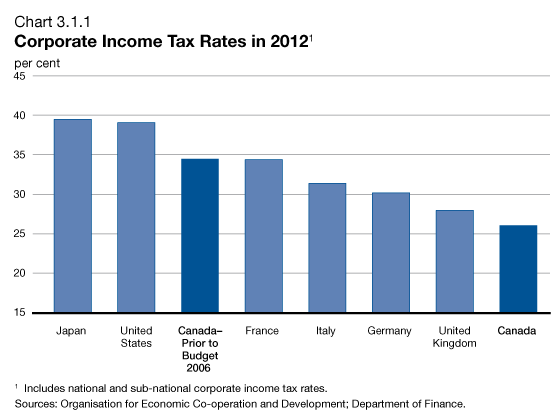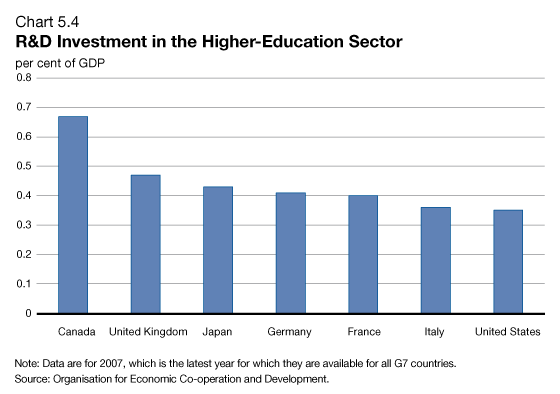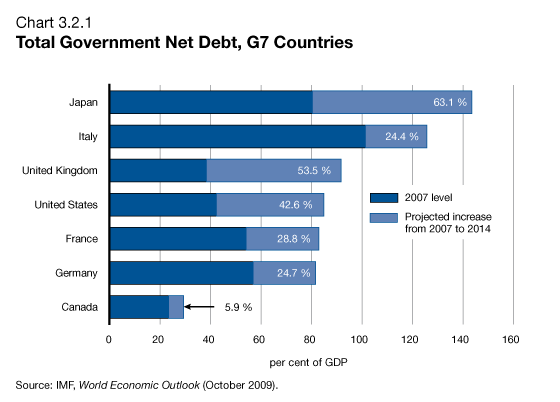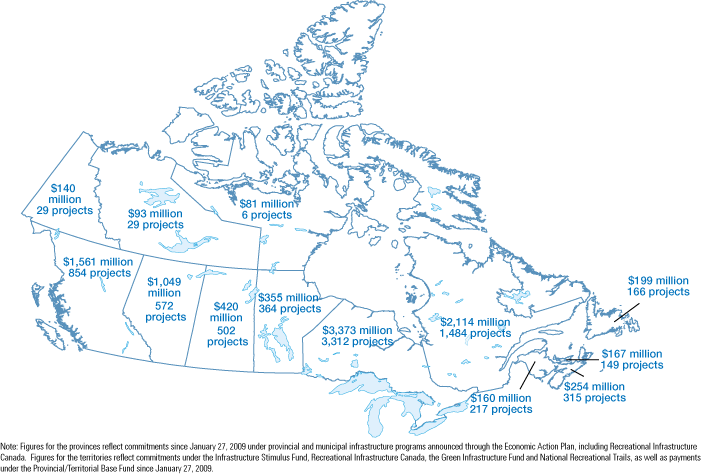Common menu bar links
Archived - Sustaining Canada's Economic Advantage
Canada’s Economic Action Plan was designed to protect Canadians from the effects of the global recession.
The Plan is working to stimulate the economy now, creating jobs and growth.
It also advances the goals set out in the Government’s long-term vision for the economy, Advantage Canada, which aims to strengthen five key strategic advantages for Canada in the global economy.
Since 2006, including measures in the Economic Action Plan and Budget 2010, the Government has made significant strides in realizing this long-term vision. As a result, Canada will recover from the recession with a stronger economic advantage than before.
Tax Advantage
Canada’s Economic Action Plan introduces over $20 billion in new tax relief in 2008–09 and over the following five fiscal years. Canada will emerge from the recession with a highly competitive tax system. For example:
- This year, Canada will have an overall tax rate on new business investment that is the lowest in the Group of Seven (G7) countries.
- By 2012, Canada will have the lowest statutory corporate income tax rate in the G7.
- The Government introduced the Tax-Free Savings Account, the most important new vehicle for savings since the introduction of the Registered Retirement Savings Plan.
- The Government introduced the Working Income Tax Benefit, lowering the “welfare wall” by making work more attractive for low-income Canadians.
- Canada’s federal tax-to-GDP (gross domestic product) ratio is at its lowest level since 1961.

A highly competitive tax system will support the creation of jobs in Canada.

Knowledge Advantage
Canada’s Economic Action Plan includes about $5 billion for post-secondary education and research, technology and innovation, and environmental protection. Along with new measures in Budget 2010, this includes:
- Creating more than 2,500 scholarships, the Canada Excellence Research Chairs initiative and additional Industrial Research and Development internships. Budget 2010 bolsters this with $45 million to create new post-doctoral fellowships.
- $2 billion to accelerate repairs, maintenance and construction at universities, colleges and research hospitals.
- $750 million to support advanced research infrastructure through the Canada Foundation for Innovation.
- $1 billion over five years under the Clean Energy Fund to support research, development and demonstration of promising clean energy technologies, including carbon capture and storage technologies.
- Expanded tax support for investment in clean energy technology and $100 million to establish the Next Generation Renewable Power Initiative, to support advanced clean energy technologies in the forestry sector.
- Over $100 million for Arctic research.
- Over $500 million in investments in space robotics and satellite technology.
In total, the Government of Canada's support for research and development (R&D) is estimated at more than $7 billion in 2009. Canada invests more in higher-education R&D as a share of the economy than any other G7 country. The Government intends to review this investment to maximize its economic benefit to Canadians.

Infrastructure Advantage
Canada’s Economic Action Plan provides about $16 billion over two years to modernize a broad range of infrastructure that supports our country’s economy, improves our quality of life, and safeguards our unique and precious environment.
A few examples include:
- $515 million to support schools, water and wastewater projects, and health and police facilities in First Nations communities.
- Funds to renew federal public infrastructure including improvements to passenger rail services, the twinning of the Trans-Canada Highway through Banff National Park, major repairs to the Champlain Bridge in Montréal, and better border facilities.
- Historic investments in social housing with total federal investment of over $2 billion.
- Significant tax support for home ownership and renovations with millions of Canadian families taking advantage of the temporary Home Renovation Tax Credit, and additional tax support to first-time home buyers.
- A total of $585 million for Canadian homeowners to make energy efficiency improvements to their homes through the enhanced ecoENERGY Retrofit–Homes program.
These investments are helping to create and maintain jobs across Canada and will ensure the country emerges from the economic downturn with a more modern and greener infrastructure.

Entrepreneurial Advantage
To make Canada a more competitive place for business, the Economic Action Plan and Budget 2010 give Canada a tariff advantage over its trading partners, an improved tax system, less red tape for business, and reduced barriers to competition and innovation.These measures include:
- Making Canada a tariff-free zone for industrial manufacturing by eliminating tariffs on all manufacturing inputs and machinery and equipment. Most will be dropped immediately; the remainder will be eliminated by 2015. Once complete, this action will provide an additional $300 million in annual duty savings for Canadian businesses and is expected to result in the creation of 12,000 jobs.
- Reducing red tape by taking steps to reduce the paperwork burden on Canadian businesses and launching a new Red Tape Reduction Commission.
- Increasing competition in telecommunications by removing the existing restrictions on foreign ownership of Canadian satellites. This will encourage foreign investment in the sector and improve its competitiveness.
- Investing in agriculture by providing $500 million for the Agricultural Flexibility program and $50 million for the Slaughter Improvement program. These measures will help the sector adapt to pressures and improve its competitiveness.
- Establishing a Canadian securities regulator with the voluntary partnership of provinces and territories. The new regulator would better protect investors, strengthen financial sector stability and reduce paperwork and costs for investors.
Fiscal Advantage
Canada entered the global recession as the only G7 nation with a record of fiscal surpluses. By 2007, our total government net debt had declined to 23.5 per cent of GDP.
This low public debt reduces borrowing costs, reduces Canada’s reliance on foreign borrowing, strengthens our capacity to withstand economic shocks and lightens the burden of payments for future generations.
After taking the necessary step of running a deficit to fund the Economic Action Plan and protect the Canadian economy, the Government is outlining a three-point plan to reduce the deficit once the economy has recovered. The plan will:
- Follow through on the Economic Action Plan’s “exit strategy” to wind down the temporary spending measures as planned.
- Restrain government spending through targeted measures.
- Review government administrative functions and overhead costs to identify additional savings and improve service delivery.
The Government will not raise taxes and will not cut major transfers for health care, education, and pensioners.
- To help return to balanced budgets, Budget 2010 announces $17.6 billion in total savings over five years. This will cut the deficit in half in two years and by two-thirds in three years, keeping our finances ahead of the curve internationally.

- This will sustain Canada’s fiscal advantage, which is the envy of the world.
Sustaining Our Economic Advantage
Canada entered the global recession from a position of strength, and we are well placed to emerge from the recession stronger than ever.
The steps we are taking are consistent with our long-term vision, Advantage Canada.
We are helping Canadians get the skills they need for the jobs of tomorrow while protecting and creating jobs today. We are building the modern infrastructure on which future jobs depend.
The Government is positioning Canada as a place where jobs will be created for the long-term; a low-tax, investment-friendly country, committed to free and open trade and unhindered by the massive debt burden of our competitors.
